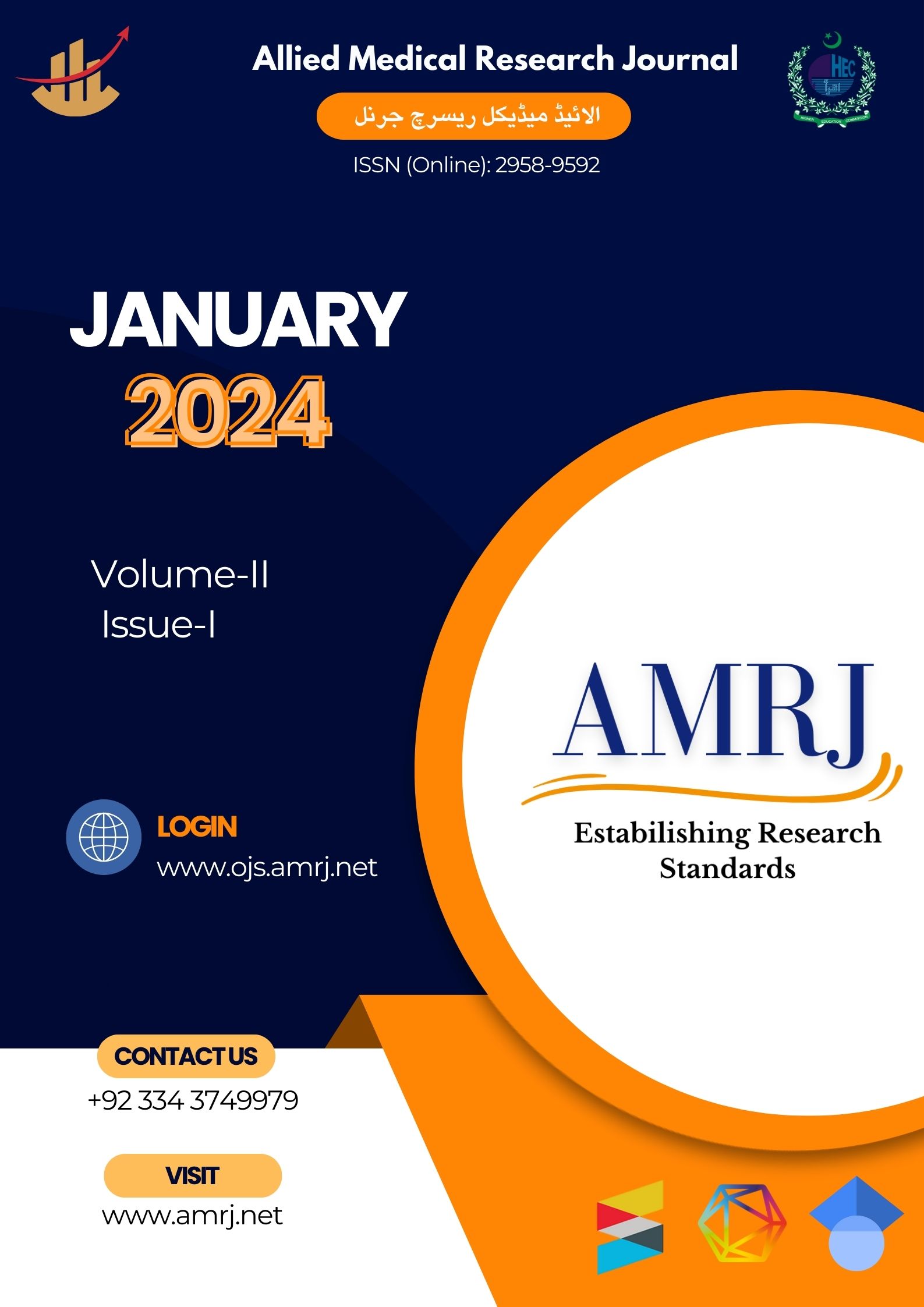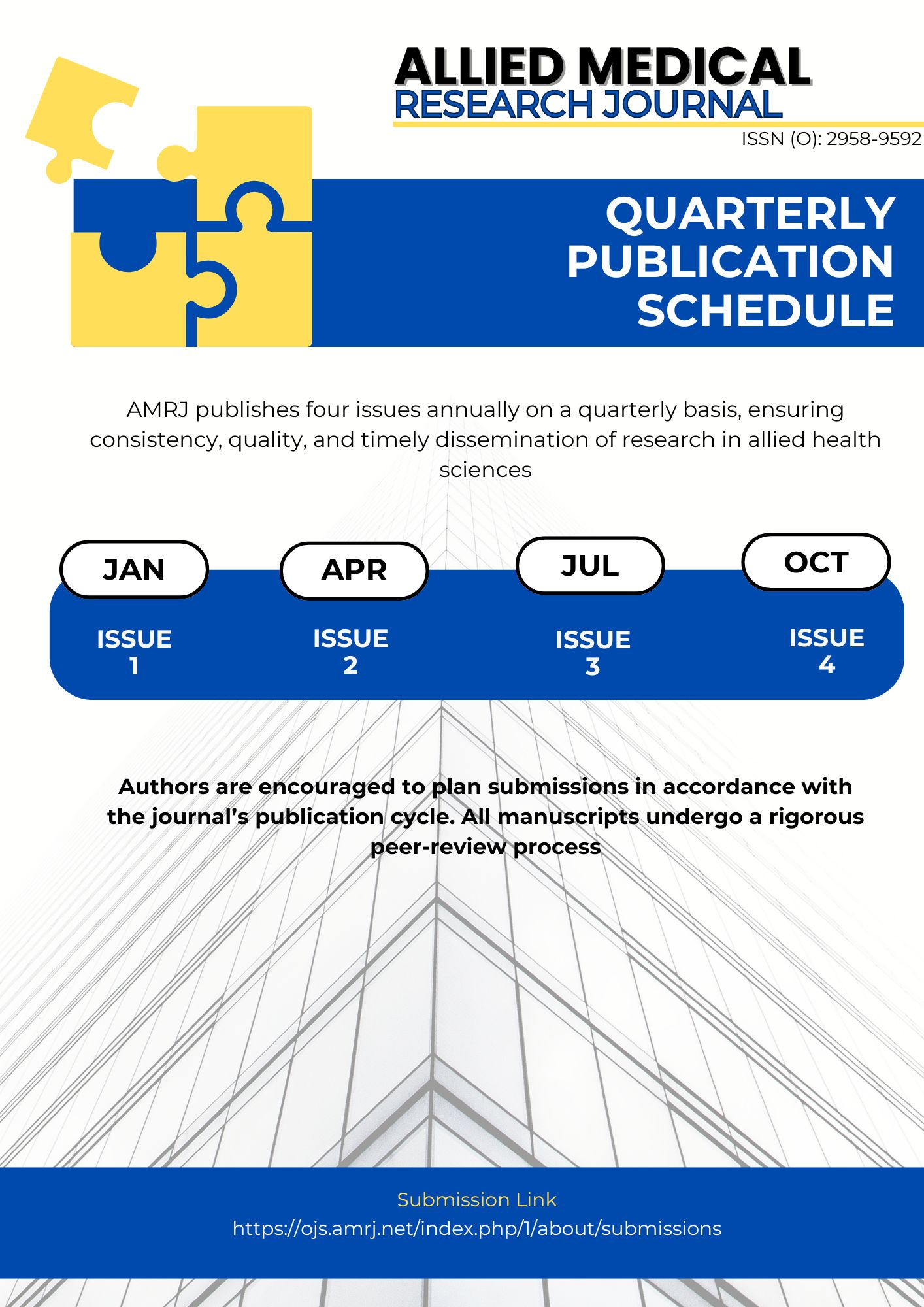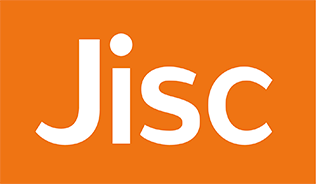Rejuvenating Mobility: Impact of Concurrent Exercise on Functional Claudication Distance and vascular health among Patients with T2DM-associated PAD
Concurrent Exercise for T2DM-associated PAD Patients
Keywords:
Claudication Distance, Diabetic Vascular Complication, Peripheral Artery Disease, Type-2 Diabetes Mellitus, Vascular Quality of LifeAbstract
Background: Globally, the diabetes epidemic has increased in the general population over the last few decades. Despite the higher prevalence of Type-II DM, evidence about Diabetes-related vascular complications is scarce. Therefore, this study aims to determine appropriate exercise training in clinical settings effectively, reducing risk factors for T2DM-associated PAD patients.
Methods: At the Department of Rehabilitation Sciences of Dr. Ziauddin Hospital Karachi, a randomized, single-blinded, two-arm trial was conducted from July to September 2023. Eighty patients with T2DM-associated PAD were recruited and randomly assigned into two groups Using the sealed envelope approach: Group A (n=40) and Group B (n=40). For 12 weeks, participants in Group B performed Aerobic Training (AT), while Group A participated in Concurrent Training (CT) 3 times a week. Functional Claudication Distance (FCD) and VascuQol-6 were measured pre and post-12-week intervention for measuring functional capacity and vascular health.
Results: Findings revealed that CT training groups significantly improved FCD and VascuQol-6 after 12 weeks (p<0.000). Subsequently, findings showed that the CT group showed more significant improvement than AT in improving FCD (p=0.013, CT: pre: 203.33±1.78, post: 230.65±7.72, AT: pre: 203.08±2.2, post: 214.13±5.1) and VascuQol-6 (p=0.0001, CT: pre: 10.60±2.11, post: 19.88±1.24, AT: pre: 9.53±2, post: 14.33±1.97).
Conclusion: Patients’ reported vascular health and FCD significantly improved by the CT than the AT group. Therefore, CT appears to be an exceptionally beneficial therapeutic strategy for the management of Fontaine’s stage II, a PADassociated with T2DM.
References
Home, Resources, diabetes L with, Acknowledgement, FAQs, Contact, et al. IDF Diabetes Atlas 2021 | IDF Diabetes Atlas [Internet]. IDF Diabetes Atlas. 2021. Available from: https://diabetesatlas.org/atlas/tenth-edition/
Harding JL, Pavkov ME, Magliano DJ, Shaw JE, Gregg EW. Global trends in diabetes complications: a review of current evidence. Diabetologia. 2019 Jan;62:3-16. DOI: https://doi.org/10.1007/s00125-018-4711-2
Haghighatpanah M, Nejad AS, Haghighatpanah M, Thunga G, Mallayasamy S. Factors that correlate with poor glycemic control in type 2 diabetes mellitus patients with complications. Osong public health and research perspectives. 2018 Aug;9(4):167. DOI: https://doi.org/10.24171%2Fj.phrp.2018.9.4.05
Makizako H, Shimada H, Doi T, Tsutsumimoto K, Hotta R, Nakakubo S, Makino K, Lee S. Social frailty leads to the development of physical frailty among physically non-frail adults: a four-year follow-up longitudinal cohort study. International journal of environmental research and public health. 2018 Mar;15(3):490. DOI: https://doi.org/10.3390/ijerph15030490
Grant PJ, Cosentino F. The 2019 ESC Guidelines on diabetes, pre-diabetes, and cardiovascular diseases developed in collaboration with the EASD: New features and the ‘Ten Commandments’ of the 2019 Guidelines are discussed by Professor Peter J. Grant and Professor Francesco Cosentino, the Task Force chairmen. DOI: https://doi.org/10.1093/eurheartj/ehz687
Uddin F, Ali B, Junaid N. Prevalence of diabetic complications in newly diagnosed type 2 diabetes patients in Pakistan: findings from national registry. Journal of Ayub Medical College Abbottabad. 2019 Jan 15;30(4-Sup).
Transcript Webinar 3. (n.d.). [online] Available at: https://www.heart.org/-/media/Files/Health-Topics/Peripheral-Artery-Disease/PAD-Webinars/Webinar-3-Exercise-Therapy-for-PAD-transcript.pdf [Accessed 29 Oct. 2022].
Shu J, Santulli G. Update on peripheral artery disease: Epidemiology and evidence-based facts. Atherosclerosis. 2018 Aug 1;275:379-81. DOI: https://doi.org/10.1016/j.atherosclerosis.2018.05.033
McDermott MM, Dayanidhi S, Kosmac K, Saini S, Slysz J, Leeuwenburgh C, Hartnell L, Sufit R, Ferrucci L. Walking exercise therapy effects on lower extremity skeletal muscle in peripheral artery disease. Circulation research. 2021 Jun 11;128(12):1851-67. DOI: https://doi.org/10.1161/CIRCRESAHA.121.318242
Nazir A. Physiological Effects and Prescription of Exercise in Patients with Peripheral Artery Disease. Indonesian Journal of Physical Medicine and Rehabilitation. 2021;10(01):11-21. DOI: https://doi.org/10.36803/ijpmr.v10i1.279
Ogando PH, Silveira-Rodrigues JG, Melo BP, Campos BT, Silva AD, Barbosa EG, Aleixo IM, Soares DD. Effects of high-and moderate-intensity resistance training sessions on glycemia of insulin-treated and non-insulin-treated type 2 diabetes mellitus individuals. Sport Sciences for Health. 2023 Jun;19(2):625-36. DOI: https://doi.org/10.1007/s11332-022-00931-2
Criqui MH, Matsushita K, Aboyans V, Hess CN, Hicks CW, Kwan TW, McDermott MM, Misra S, Ujueta F. Lower extremity peripheral artery disease: contemporary epidemiology, management gaps, and future directions: a scientific statement from the American Heart Association. Circulation. 2021 Aug 31;144(9):e171-91. DOI: https://doi.org/10.1161/CIR.0000000000001005
Farhad A, Farooqui SI, Amjad S, Khan AA. Role of structured and supervised exercise programmes in peripheral artery disease patients with and without claudication-A Systematic Review and Metaanalysis. JPMA. The Journal of the Pakistan Medical Association. 2019 Jun 1;69(6):874-8.
Machado I, Sousa N, Paredes H, Ferreira J, Abrantes C. Combined aerobic and resistance exercise in walking performance of patients with intermittent claudication: systematic review. Frontiers in physiology. 2020 Jan 8;10:1538. DOI: https://doi.org/10.3389/fphys.2019.01538
Sinnige A, Kittelson A, Van der Wees PJ, Teijink JA, Hoogeboom TJ. Personalised outcomes forecasts of supervised exercise therapy in intermittent claudication: An application of neighbours based prediction methods with routinely collected clinical data. European Journal of Vascular and Endovascular Surgery. 2022 Apr 1;63(4):594-601. DOI: https://doi.org/10.1016/j.ejvs.2021.12.040
Bubb KJ, Harmer JA, Finemore M, Aitken SJ, Ali ZS, Billot L, Chow C, Golledge J, Mister R, Gray MP, Grieve SM. Protocol: Protocol for the Stimulating β3-Adrenergic Receptors for Peripheral Artery Disease (STAR-PAD) trial: a double-blinded, randomised, placebo-controlled study evaluating the effects of mirabegron on functional performance in patients with peripheral arterial disease. BMJ Open. 2021;11(9). DOI: https://doi.org/10.1136%2Fbmjopen-2021-049858
Larsen AS, Reiersen AT, Nådland IH, Wesche J. Self-reported health status and disease-specific quality of life one year after treatment for peripheral arterial disease in clinical practice. Health and Quality of Life Outcomes. 2020 Dec;18:1-8. DOI: https://doi.org/10.1186/s12955-020-01477-y
Ampuero DV, Lorca ME, Cantillana CC, Pérez DV, Queiroz AC, dos Santos DA, Miarka B, de Toledo Nóbrega O, Brito CJ. The effect of aerobic and concurrent training on cardiovascular and metabolic control in middle-aged type II diabetics. Journal of Physical Education and Sport. 2023 Mar 1;23(3):631-6. DOI: 10.7752/jpes.2023.03078
Agner VF, Garcia MC, Taffarel AA, Mourão CB, da Silva IP, da Silva SP, Peccin MS, Lombardi Jr I. Effects of concurrent training on muscle strength in older adults with metabolic syndrome: A randomized controlled clinical trial. Archives of gerontology and geriatrics. 2018 Mar 1;75:158-64. DOI: https://doi.org/10.1016/j.archger.2017.12.011
Vechin FC, Conceição MS, Telles GD, Libardi CA, Ugrinowitsch C. Interference phenomenon with concurrent strength and high-intensity interval training-based aerobic training: an updated model. Sports Medicine. 2021 Apr;51(4):599-605. DOI: https://doi.org/10.1007/s40279-020-01421-6
Moghadam BH, Bagheri R, Ashtary-Larky D, Tinsley GM, Eskandari M, Wong A, Moghadam BH, Kreider RB, Baker JS. The effects of concurrent training order on satellite cell-related markers, body composition, muscular and cardiorespiratory fitness in older men with sarcopenia. The journal of nutrition, health & aging. 2020 Jul;24:796-804. DOI: https://doi.org/10.1007/s12603-020-1431-3
Sousa AC, Neiva HP, Izquierdo M, Cadore EL, Alves AR, Marinho DA. Concurrent training and detraining: brief review on the effect of exercise intensities. International journal of sports medicine. 2019 Nov;40(12):747-55. DOI: 10.1055/a-0975-9471

Downloads
Published
Issue
Section
License
Copyright (c) 2024 Uroosa Amin, Qurat-ul-Ain Adnan, Dr. Tauseef Ahmad

This work is licensed under a Creative Commons Attribution-NonCommercial 4.0 International License.








